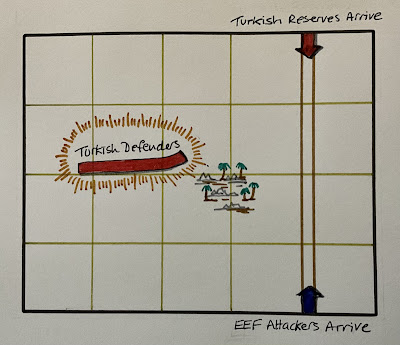This week I was able to host a remote war game with Jon of Palouse Wargaming Journal. This was a great pick up for me, as the previous weekend I had caught Covid-19 and had spent this week recovering. Fortunately the scenario - the Battle or Auberoche, 1345 - had been planned and written up prior to becoming ill.
Background
A French force of 7,000 is besieging the castle of Auberoche held by a small Anglo-Gascon garrison. The French encampment was divided in two, with the majority of the soldiers camped close to the river between the castle and village, while a smaller force was situated to prevent any relief attempts from the north.
Warned of the siege, the Earl of Derby gathered a force of 1,500 and waited near for reinforcements. As no reinforcements had arrived by October 20th Derby called a council of his officers. It was decided that rather than wait and lose the advantage of surprise, the army would attack immediately and attempt to overrun the main French camp.
 |
| Map from “Wargaming Ancient and Medieval Periods” by Donald Featherstone |
The attack was launched just as the French were having their evening meal. Complete surprise was achieved. The longbowmen shot from the treeline into the tightly packed French camp. While the French were confused and distracted by this attack from the west, Derby made a cavalry charge with his 400 men-at-arms from the south. The French although superior in numbers were struggling to get into their armour and organise a defence.
The castle garrison realised the position of the French troops and sallied forth with all their mounted men and attacked. This unexpected attack on the French rear caused their defence to collapse and they routed.
The Game
The game is based upon scenario 22 “Ambush” from One-Hours Wargames by Neil Thomas, which is based upon the battle, is played on a 4 by 5 foot area. The tabletop area is dictated by the camera and the amount of tabletop it can cover.
 |
| This is the tabletop setup from an earlier game, and if you are now wondering why is he using photos from earlier games? Yes, I forgot to take photos again! Well I took one photo, and improvement on previous games. |
Order of Battle…
Deployment…
French - all units must be deployed within 6” of the two tents in a disordered state. 4 units must be positioned within 6” of the west tent.
Anglo-Gascon - One mounted men at arms units is positioned in the castle, while all other units are deployed having just moved out of the woods. The two mounted men at arms with a commander are positioned in the clearing to the south of the woods.
 |
| The scenario map showing deployment areas |
Special Rules…
Castle - Cannot be attacked and the garrison cannot sally forth until the turn 6.
Surprise - No French unit can activate until turn 3.
Derby’s Charge - The mounted men at arms unit cannot move until turn 3.
Game Length…
15 Turns. The Anglo-Gascon army starts the turn.
Winning…
The Anglo-Gascon force must defeat the French by reducing their army to less than 2 units. Failure to do this will constitute a French victory.
The Game Report…
Jon chose the French force and positioned his mounted men at arms furthest away from the woods. While most of the levy units (representing men unable to get their armour) were positioned nearest the woods and castle.
The Anglo-Gascon force having emerged from the woods spent their first 3 turns shooting at the French, quickly eliminating two levy units. Jon started to organise a defensive line of crossbow men and men at arms, while his mounted men at arms moved towards his southern flank.
The Anglo-Gascon bowmen pushed forward and the Earl of Derby’s mounted force charged forward into the hastily gathered French defensive line. The situation for the French was looking rather bleak.
The French position started to stabilise and Jon was able to get his mounted forces engaged in the battle. About the same time a mounted force sallied forth from the castle into the waiting levy. It was around this time the French mounted men at arms started to gain the upper hand and the Earl of Derby fell and was carried from the field of battle.
The castle’s mounted force had by now disposed of the levy, exposing the French rear to attack. The lack of Derby’s command meant the attacking Anglo-Gascon units began to lack motivation (it was harder to activate them after the loss of their commander) not that any French victory was assured. The French defensive line was rather thin and retiring in the face of the bowmen. All their hopes were pinned on their remaining mounted unit which was starting to charge into the bowmen with devastating effect.
The Anglo-Gascon force failed a number of activations and they missed opportunities to follow up on the weak French defensive line. The French seized their opportunity and their mounted unit, lead by their commander, routed the bowmen and the battle was over.
Thoughts
A thoroughly enjoyable game to participate in. One in which I thought I had victory in the bag early on, but Jon was able to muster and steady his troops into a defensive line, then use his mounted units very effectively to turn the game around. A well deserved victory to Jon.
It is an interesting ambush scenario (#22) from One-Hour Wargames. It is a scenario I have overlooked for a long time as I thought it would not be interesting, but having now played it a few times, all medieval mind you, it never ceases to give a good game.

























